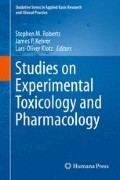Abstract
In the 1983 movie, Never Say Never Again, the threat to human civilization of greatest concern to those selected to protect us from evil was identified thus:
Access this chapter
Tax calculation will be finalised at checkout
Purchases are for personal use only
References
Smith CV (2005) Compartmentalization of redox regulation of cell response. Toxicol Sci 83(1):1–3
Jollow DJ, Mitchell JR, Potter WZ, Davis DC, Gillette JR, Brodie BB (1973) Acetaminophen-induced hepatic necrosis. II. Role of covalent binding in vivo. J Pharmacol Exp Ther 187:195–202
Mitchell JR, Jollow DJ, Potter WZ, Davis DC, Gillette JR, Brodie BB (1973) Acetaminophen-induced hepatic necrosis. I. Role of drug metabolism. J Pharmacol Exp Ther 187:185–194
Mitchell JR, Jollow DJ, Potter WZ, Gillette JR, Brodie BB (1973) Acetaminophen-induced hepatic necrosis. IV. Protective role of glutathione. J Pharmacol Exp Ther 187:211–217
Potter WZ, Davis DC, Mitchell JR, Jollow DJ, Gillette JR, Brodie BB (1973) Acetaminophen-induced hepatic necrosis. III. Cytochrome P-450-mediated covalent binding in vitro. J Pharmacol Exp Ther 187:203–210
Smith CV, Mitchell JR (1985) Acetaminophen hepatotoxicity in vivo is not accompanied by oxidant stress. Biochem Biophys Res Commun 133(1):329–336
Miller MG, Jollow DJ (1984) Effect of L-ascorbic acid on acetaminophen-induced hepatotoxicity and covalent binding in hamsters. Evidence that in vitro covalent binding differs from that in vivo. Drug Metab Dispos 12(3):271–279
Corcoran GB, Racz WJ, Smith CV, Mitchell JR (1985) Effects of N-acetylcysteine on acetaminophen covalent binding and hepatic necrosis in mice. J Pharmacol Exp Ther 232(3):864–872
Rogers LK, Moorthy B, Smith CV (1997) Acetaminophen binds to mouse hepatic and renal DNA at human therapeutic doses. Chem Res Toxicol 10(4):470–476
Tsokos-Kuhn JO, Hughes H, Smith CV, Mitchell JR (1988) Alkylation of the liver plasma membrane and the inhibition of the Ca2+ ATPase by acetaminophen. Biochem Pharmacol 37:2125–2131
Perneger TV, Whelton PK, Klag MJ (1994) Risk of kidney failure associated with the use of acetaminophen, aspirin, and nonsteroidal antiinflammatory drugs. N Eng J Med 331:1675–1679
Allegaert K, Anderson B, Simons S, van Overmeire B (2013) Paracetamol to induce ductus arteriosus closure: is it valid? Arch Dis Child 98(6):462–466
Jaeschke H, Williams CD, McGill MR (2012) Caveats of using acetaminophen hepatotoxicity models for natural product testing. Toxicol Lett 215(1):40–41
Kadiiska MB, Gladen BC, Baird DD, Dikalova AE, Sohal RS, Hatch GE, Jones DP, Mason RP, Barrett JC (2000) Biomarkers of oxidative stress study: are plasma antioxidants markers of CCl(4) poisoning? Free Radic Biol Med 28(6):838–845
Kadiiska MB, Gladen BC, Baird DD, Germolec D, Graham LB, Parker CE, Nyska A, Wachsman JT, Ames BN, Basu S, Brot N, Fitzgerald GA, Floyd RA, George M, Heinecke JW, Hatch GE, Hensley K, Lawson JA, Marnett LJ, Morrow JD, Murray DM, Plastaras J, Roberts LJ 2nd, Rokach J, Shigenaga MK, Sohal RS, Sun J, Tice RR, Van Thiel DH, Wellner D, Walter PB, Tomer KB, Mason RP, Barrett JC (2005) Biomarkers of oxidative stress study II: are oxidation products of lipids, proteins, and DNA markers of CCl4 poisoning? Free Radic Biol Med 38(6):698–710
Kadiiska MB, Gladen BC, Baird DD, Graham LB, Parker CE, Ames BN, Basu S, Fitzgerald GA, Lawson JA, Marnett LJ, Morrow JD, Murray DM, Plastaras J, Roberts LJ 2nd, Rokach J, Shigenaga MK, Sun J, Walter PB, Tomer KB, Barrett JC, Mason RP (2005) Biomarkers of oxidative stress study III. Effects of the nonsteroidal anti-inflammatory agents indomethacin and meclofenamic acid on measurements of oxidative products of lipids in CCl4 poisoning. Free Radic Biol Med 38(6):711–718
Lauterburg BH, Smith CV, Hughes H, Mitchell JR (1984) Biliary excretion of glutathione and glutathione disulfide in the rat. Regulation and response to oxidative stress. J Clin Invest 73(1):124–133
Smith CV, Mitchell JR (1989) Pharmacological aspects of glutathione in drug metabolism. In: Dolphin D, Poulson R, Avramovic O (eds) Coenzymes and cofactors. Wiley, New York, pp 1–44
Smith CV, Hughes H, Lauterburg BH, Mitchell JR (1983) Chemical nature of reactive metabolites determines their biological interactions with glutathione. In: Larsson A, Orrenius S, Holmgren A, Mannervik B (eds) Functions of glutathione: biochemical, physiological, toxicological, and clinical aspects. Raven, New York, pp 125–138
Smith CV (1991) Correlations and apparent contradictions in assessment of oxidant stress status in vivo. Free Radic Biol Med 10(3–4):217–224
Lenz ML, Hughes H, Mitchell JR, Via DP, Guyton JR, Taylor AA, Gotto AM Jr, Smith CV (1990) Lipid hydroperoxy and hydroxy derivatives in copper-catalyzed oxidation of low density lipoprotein. J Lipid Res 31(6):1043–1050
Lynch SM, Morrow JD, Roberts LJ, Frei B (1994) Formation of non-cyclooxygenase-derived prostanoids (F2-isoprostanes) in plasma and low density lipoprotein exposed to oxidative stress in vitro. J Clin Invest 93(3):998–1004
Wendel A, Feuerstein S, Konz K-H (1979) Acute paracetamol intoxication of starved mice leads to lipid peroxidation in vivo. Biochem Pharmacol 28:2051–2055
Wendel A, Feuerstein S (1981) Drug-induced lipid peroxidation in mice-I. Modulation by monooxygenase activity, glutathione and selenium status. Biochem Pharmacol 30:2513–2520
Smith CV, Reilly MH (1989) Formation of pentane versus 1-pentanol in the ferrous sulfate initiated decomposition of 15-hydroperoxyeicosatetraenoic acid in hypoxic and hyperoxic conditions. Biochem Pharmacol 38:1362–1364
Hughes H, Smith CV, Horning EC, Mitchell JR (1983) High performance liquid chromatography and gas chromatography-mass spectrometry determination of specific lipid peroxidation products in vivo. Anal Biochem 130:431–436
Hughes H, Smith CV, Tsokos-Kuhn JO, Mitchell JR (1986) Quantitation of lipid peroxidation products by gas chromatography-mass spectrometry. Anal Biochem 152(1):107–112
Author information
Authors and Affiliations
Corresponding author
Editor information
Editors and Affiliations
Rights and permissions
Copyright information
© 2015 Springer International Publishing Switzerland
About this chapter
Cite this chapter
Smith, C.V. (2015). Oxidants, Radicals, Free Radicals, and Other Bad Stuff in Mechanisms of Toxicity. In: Roberts, S., Kehrer, J., Klotz, LO. (eds) Studies on Experimental Toxicology and Pharmacology. Oxidative Stress in Applied Basic Research and Clinical Practice. Humana Press, Cham. https://doi.org/10.1007/978-3-319-19096-9_3
Download citation
DOI: https://doi.org/10.1007/978-3-319-19096-9_3
Publisher Name: Humana Press, Cham
Print ISBN: 978-3-319-19095-2
Online ISBN: 978-3-319-19096-9
eBook Packages: Biomedical and Life SciencesBiomedical and Life Sciences (R0)

